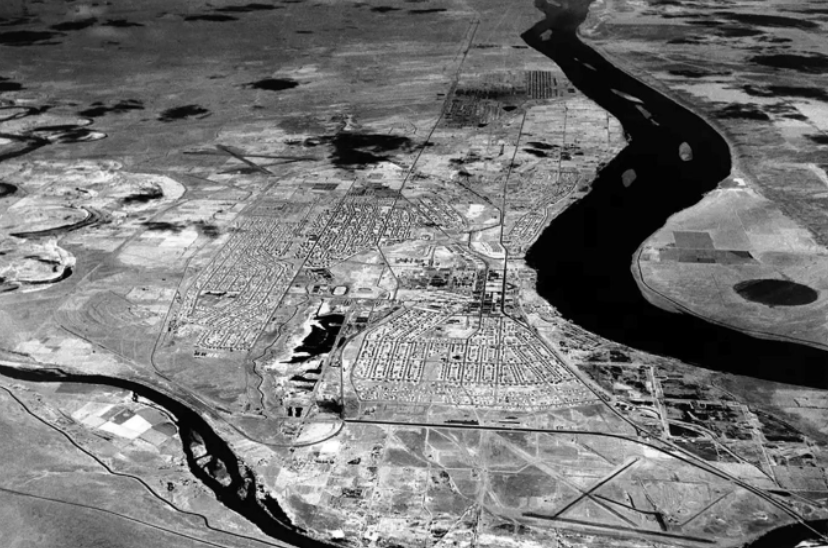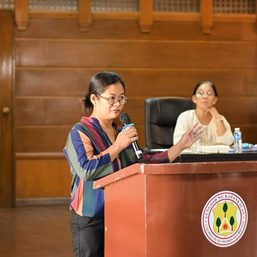SUMMARY
This is AI generated summarization, which may have errors. For context, always refer to the full article.
![[OPINION] The Hanford Site: Where nuclear pollution began and still reigns](https://www.rappler.com/tachyon/2022/04/Screen-Shot-2022-04-20-at-3.17.41-PM.png)
The following is the 30th in a series of excerpts from Kelvin Rodolfo’s ongoing book project “Tilting at the Monster of Morong: Forays Against the Bataan Nuclear Power Plant and Global Nuclear Energy.“
This foray is the first of six about radioactive wastes. Why so many? Waste disposal is the very worst, unsolvable problem from nuclear weapons and power plants! People must understand that should the Bataan Nuclear Power Plant (BNPP) be activated, its wastes will be impossible to get rid of, and will permanently harm the environment.
Hanford is the first and worst toxic nuclear-waste dump in the US and possibly the world (although we don’t know what Russia might be hiding). The plutonium for “Fat Man,” the 21-kiloton bomb that destroyed Nagasaki in 1945, was manufactured out of uranium at the Hanford site, 586 square miles (about 1,500 square kilometers) of inconspicuous desert in south-central Washington State. After World War II the facility was expanded to nine reactors and five reprocessing complexes.
We won’t discuss how horribly indigenous and other local people and workers suffered from Hanford, but I can provide an internet link.
Hanford sits on the west bank of the Columbia River for two reasons. Running the reactors required huge amounts of energy; the Grand Coulee Dam 156 miles upstream provided it. The reactors generated great amounts of waste heat and had to be kept cool. So, it sucked huge volumes of water out of the river, passed them through its machinery, and spewed them back, heated, into the river to flow 200 miles down to the Pacific Ocean.
Thirty miles (50 kilometers) downstream, the water from the plant was still warm. Little attention was paid to how it might affect river life, including salmon and other commercial and game fish.

How radioactive substances affect health and the environment was not understood back then. A curie is how much radiation and how fast a gram of radium emits it: 37 billion emissions per second. Hanford dumped 110 million curies into the Columbia River. A whale caught off the Oregon coast in 1960 was emitting gamma rays because it had fed on plankton contaminated by Hanford’s waste.
Excuses: in 1962, Manhattan Project head General Leslie Groves said, “Nothing like this had ever been attempted before…the great risk involved in designing, constructing, and operating plants such as these…simply had to be accepted.” This was also long before “environmental impact assessment.” Unfortunately, sloppy procedures excused by the urgencies of war continue to this day.
Authorities also didn’t pay much attention to the huge quantities of radioactive gases Hanford released from 1944 to 1972. This included 725,000 curies of highly radioactive Iodine 131 from 1944 to 1957 alone, about 30,000 times as much as the Three Mile Island nuclear accident emitted in 1979. Of course, thyroid cancers increased in citizens downwind of the site.
By 1991 when the Soviet Union collapsed and the Cold War ended, Hanford had processed 96,900 tons of uranium to make the plutonium for about two thirds of the 60,000 US nuclear weapons. Remarkably, that was only 67 tons of plutonium, dwarfed by the huge amount of waste produced.
More than 700,000 cubic meters of solid waste contaminated clothing, tools, broken equipment was buried at sites scattered haphazardly across the desert. Earlier burials were unmarked and unrecorded, and so belated efforts to deal with those wastes properly have been difficult. The waste contains enough plutonium to make 1,800 bombs the size of Fat Man.

Of even greater concern is how the site disposed of millions of cubic meters of liquid radioactive waste. Hundreds of thousands of cubic meters were injected directly into the ground with wells, or were buried in trenches and drums.
In addition, more than 200,000 cubic meters of high-level liquid and solid radioactive waste were originally stored in 177 single-walled tanks starting in 1943. The left panel below shows some of them being constructed around 1944. They were designed to last 20 years but started leaking much sooner, in 1956. Despite that, surprisingly, the site managers continued to build them until 1964.
Finally, in 1968 the US Department of Energy started building 28 new double-shelled tanks, pictured in the right panel below. In 2011, the liquid from 149 of the old tanks began to be transferred into the new ones. But by 1989 water had leaked into 68 of the old tanks, and, bearing much toxic radiation, was leaking back out and into the ground. Then, in 2012 DOE found that half of the new tanks were also leaking.

For almost half a century, rigorous military security had made it easy for Hanford’s managers to insist that any leakage from the tanks would be insignificant and easily absorbed by the underlying soil – even though it knew about the problem since 1989. Only in 1998 after whistleblower reports did DOE admit that 4,000 cubic meters had leaked into the ground, polluting the groundwater and leaking into the Columbia River, and that it did not know how to clean it up.
It seems the Department never studied the problem properly simply because it didn’t want to know. Since then, it has spent billions of dollars struggling unsuccessfully to solve it.
The radioactive pollutants in Hanford’s groundwater include Uranium, Technetium 99, Tritium, and Strontium 90. Uranium decays to other elements such as radioactive radon. Technetium contributes most of the total long-lived radiation emissions from nuclear waste.
As we saw in our last foray, Tritium, if you inhale, eat, drink, or absorb it through your skin, emits beta particles inside you that can cause cancer. Strontium 90 substitutes for calcium in bones and marrow, and causes leukemia and cancer in bone and surrounding tissues. Iodine 129 is soluble in water, so it moves easily through the environment. Its half-life of almost 16 million years means it will pollute Hanford forever.
Other non-radioactive toxic pollutants in Hanford groundwater include chromium and carbon tetrachloride. A “hexavalent” form of chromium is toxic to the blood and genetic material, and causes cancer in lungs, kidneys, and livers. Carbon tetrachloride damages the nervous system when inhaled, and is a very potent carcinogen, especially in livers and kidneys.
And what is the final solution for the 56 million gallons of radioactive waste water? That’s 212,000 cubic meters. In 1989 they planned to mix it with boron and other materials, melt it by heating it to 1150 °C (about 2100°F) and store it as glass in stainless-steel barrels underground.
After many years, in 2002 they finally began constructing the Hanford Waste Treatment and Immobilization Plant. But many technical issues and delays kept postponing its starting date. It is now in danger of not meeting a court-imposed deadline of 2036 to start operation, and its cost has ballooned to $17 billion.
In 2019 the estimated total cost of the Hanford Site cleanup was $242 billion; in February 2022 it had risen to $340 to 600 billion. Now they say most cleanup will be done by about 2078.
Any chance those costs and deadlines will change?
Our next four forays explore Enewetak Atoll, some 2,650 kilometers east of the Philippines; its people who, like Filipinos, came out of Southeast Asia millennia ago; the Cold-War Enewetak nuclear tests and the botched cleanup; how the atoll and its people were harmed; and their tragic future. – Rappler.com
Born in Manila and educated at UP Diliman and the University of Southern California, Dr. Kelvin Rodolfo taught geology and environmental science at the University of Illinois at Chicago since 1966. He specialized in Philippine natural hazards since the 1980s.
Keep posted on Rappler for the next installment of Rodolfo’s series.
Previous pieces from Tilting at the Monster of Morong:
- [OPINION] Tilting at the Monster of Morong
- [OPINION] Mount Natib and her sisters
- [OPINION] Sear, kill, obliterate: On pyroclastic flows and surges
- [OPINION] Beneath the waters of Subic Bay an old pyroclastic-flow deposit, and many faults
- [OPINION] Propaganda about faulting, earthquakes, and the Bataan Nuclear Power Plant
- [OPINION] Discovering the Lubao Fault
- [OPINION] The Lubao Fault at BNPP, and the volcanic threats there
- [OPINION] How Natib volcano and her 2 sisters came to be
- [OPINION] More BNPP threats: A Manila Trench megathrust earthquake and its tsunamis
- [OPINION] Shoddy, shoddy, shoddy: How they built the Bataan Nuclear Power Plant
- [OPINION] Where, oh where, would BNPP’s fuel come from?
- [OPINION] ‘Megatons to Megawatts’: Prices and true costs of nuclear energy
- [OPINION] Uranium enrichment for energy leads to enrichment for weapons
- [OPINION] Introducing the nuclear fuel cycle
- [OPINION] On uranium mining and milling
- [OPINION] Enriching and fabricating BNPP’s uranium fuel
- [OPINION] Decommissioning BNPP, and storing the nuclear dragon’s radioactive manure
- [OPINION] So how much greenhouse gas does nuclear power really generate?
- [OPINION] Getting up close and personal with the atom, and its nucleus that powers NPPs
- [OPINION] The nucleus and isotopes: Why BNPP needs Uranium 235, Not Uranium 238
- [OPINION] What you should know about radioactivity
- [OPINION] Uranium mine waste and the weird idea of half-life
- [OPINION] How nuclear power plants work: Hot monster piss from Morong
- [OPINION] What if there was a spent-fuel pool accident at the Bataan Nuclear Power Plant?
- [OPINION] Nuclear weaponry, its radiation, and human health
- [OPINION] What Chernobyl could have taught us, but hasn’t been allowed to
- [OPINION] Activating BNPP would give cancer to workers and adults living nearby
- [OPINION] Activate BNPP? You could increase childhood cancers in Bataan and beyond
Add a comment
How does this make you feel?










There are no comments yet. Add your comment to start the conversation.